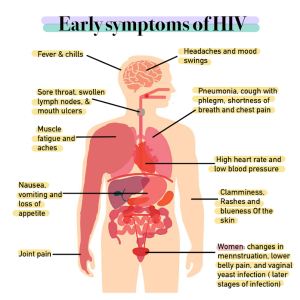HIV/AIDS Symptoms,Testing Methods, Treatment Options, and Prevention Strategie
HIV/AIDS Symptoms, which stands for Human Immunodeficiency Virus and Acquired Immunodeficiency Syndrome, is a global health issue that has claimed millions of lives since its discovery. Raising awareness about HIV/AIDS is crucial in preventing its spread, addressing stigma, and promoting early detection and treatment. Understanding the causes, symptoms, treatment options, and prevention strategies is essential for individuals and communities to effectively combat the HIV/AIDS epidemic.
What is HIV/AIDS and How Does it Spread?
HIV is a virus that attacks the immune system, specifically the CD4 cells (T cells), which help the immune system fight off infections. When left untreated, HIV can lead to the more advanced stage known as AIDS.
HIV is primarily transmitted through unprotected sexual intercourse, sharing of contaminated needles, and from an infected mother to her child during childbirth or breastfeeding. It can also be transmitted through blood transfusions or organ transplants from an infected donor, though such cases are extremely rare due to rigorous screening processes.
Stages of HIV Infection and Common Symptoms
HIV infection progresses through several stages:
- Acute HIV infection: The initial stage often presents flu-like symptoms, such as fever, fatigue, and swollen lymph nodes.
- Clinical latency: The virus may remain dormant for years with few or no symptoms, but the virus is still active and can be transmitted to others.
- AIDS: Without treatment, HIV advances to AIDS when the immune system is severely damaged. Individuals with AIDS are more susceptible to opportunistic infections and certain cancers.
Common symptoms of HIV/AIDS include persistent fever, weight loss, fatigue, diarrhea, and opportunistic infections like pneumonia and tuberculosis.
Testing Methods for Detecting HIV Infection
Several testing methods are available for detecting HIV infection, including:
- Antibody tests: These tests detect antibodies produced by the immune system in response to HIV. Results may take a few days to a few weeks.
- Nucleic acid tests (NAT): These tests directly detect the virus’s genetic material and are highly accurate but are usually reserved for specific situations, such as early detection.
- Rapid tests: These provide results in about 20 minutes and are often used in outreach and community settings.
Treatment Options for Managing HIV/AIDS Symptoms: Antiretroviral Therapy (ART)
Antiretroviral therapy (ART) is the primary treatment for HIV/AIDS. ART consists of a combination of medications that inhibit the virus’s ability to replicate, slowing down the progression of the disease and preserving immune function. While ART doesn’t cure HIV, it allows individuals with the virus to live longer and healthier lives. Adherence to the prescribed medication regimen is crucial for its effectiveness.

Prevention Strategies: Promoting Safe Practices and Education
Preventing HIV transmission involves a combination of behavioral and biomedical strategies:
- Condom use: Consistent and correct use of condoms during sexual intercourse helps prevent the sexual transmission of HIV.
- Needle exchange programs: Providing clean needles to individuals who use injectable drugs reduces the risk of HIV transmission through shared needles.
- Pre-exposure prophylaxis (PrEP): PrEP involves taking medication before potential exposure to HIV to reduce the risk of infection.
- Education and awareness: Promoting comprehensive sex education, raising awareness about HIV/AIDS, and challenging stigmas contribute to prevention efforts.
Importance of Reducing Stigma around HIV/AIDS
Stigma and discrimination associated with HIV/AIDS can hinder prevention, testing, and treatment efforts. Reducing stigma involves fostering understanding, empathy, and acceptance. Education campaigns and community engagement play crucial roles in dispelling myths and misconceptions surrounding HIV/AIDS.
Conclusion: Working Together to End the HIV/AIDS Epidemic
Ending the HIV/AIDS epidemic requires a collective effort from individuals, communities, healthcare professionals, and policymakers. This includes promoting awareness, encouraging regular testing, ensuring access to treatment, and addressing societal attitudes that contribute to stigma. By working together, we can make significant strides in preventing new infections and improving the quality of life for those living with HIV/AIDS.






